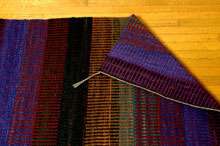No products in the cart.
Textiles to Ride

The Saddle Blanket Weaver
By Georgia Wier
On a drive back to Oregon in 2013, after having spent ten years working as a folklorist in Colorado, I arranged to make a stop in Idaho to meet Linda Morton-Keithley. At that time, Maria Carmen Gambliel was director of the Folk and Traditional Arts Program at the Idaho Commission on the Arts, and she had told me that Linda wove exceptional saddle blankets to coordinate with saddles made by her husband Gary.
I had plans to start an online gallery of folk and traditional arts made by artists living in the American West, and wanted to see whether Linda’s items fit in. As a fellow hand-weaver, I was particularly interested in her work.
We met at a fascinating store in Caldwell that displayed western goods in several small rooms. Linda brought a few handwoven rectangular throw rugs as well as her wider saddle blankets. One rug in particular struck me. When stretched out on the floor, the colors seemed to merge from one to the next: from black to blue to purple to red to dark green to rust. And Linda’s stripes weren’t monochromatic—instead, they had the two-toned look of the “pick and pick technique,” which creates rows of vertical stripes with two needles and two colors. I was totally sold on this rug.
Even if I hadn’t been a weaver, I would have realized that Linda’s work was lovely, but perhaps I wouldn’t have recognized the skill and precision she demonstrated in each piece. I particularly admired the edges (“selvage edges” in weavers’ terminology) of her woven rug. Also, I saw that the smooth braids at the ends of her rugs and saddle blankets would be the envy of any fiber artist. Together, the selvage edges and the braided ends created a woven frame—which is probably one reason some people choose to hang Linda’s rugs and blankets on the wall.
This content is available for purchase. Please select from available options.
Purchase Only
Purchase Only

